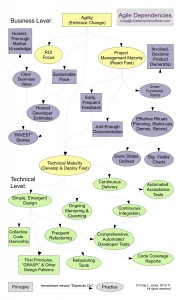- Whole Team
- Open Workspace
- Daily Standup Meetings
- Big Visible Charts
- Retrospectives
- Customer Collaboration
- Collective Code Ownership
- Simple & Evolutionary Design
- Test Driven Development
- Refactoring
- Continuous Integration
- Automated Regression Tests
- Technical Debt
- Pair Programming
- Sustainable Pace
- Iterations/Sprints
- Iteration Planning Meetings
- Show & Tells
- Frequent Releases
- Release Planning Meetings
- Story Cards w/Acceptance Criteria
Previously, I posted what I called an Agile Dependencies Chart. These two documents are remarkably similar in content. Other than the obvious fact that


